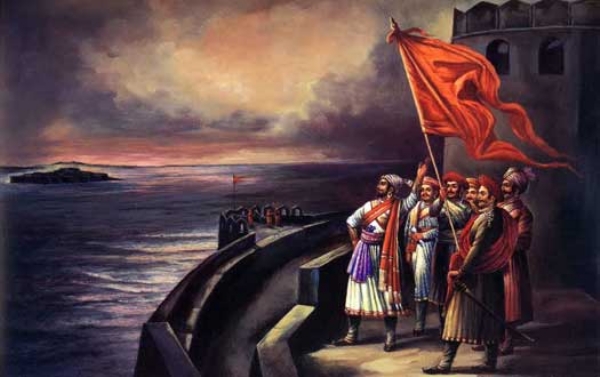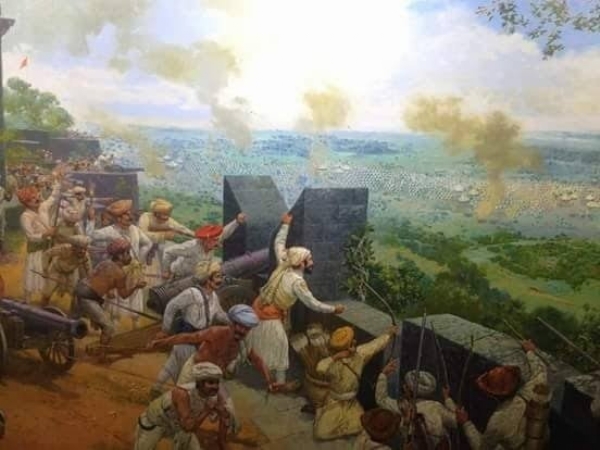Shivaji Maharaj: Armed Forces, Ordnance Management, Military Strategy & Tactics (Part 1)
Shivaji Maharaj was a Statesman of outstanding ability, he was energetic and enterprising, far Sited and secretive in his operations.
Total Views |
On the ocassion of the Chhatrapati Shivaji Maharaj's 350 coronation anniversary on June 6, Prime Minister Narendra Modi, called Maratha King the beacon of courage and bravery and said he ended the mindset of slavery.

The occasion is being celebrated in a big way for three days in Maharashtra. But he was not only hero for Maharashtra but an icon for the entire nation and the world. Chhatrapati Shivaji Maharaj was a military genius who evolved Indian way of fighting war and defeated the enemies with Indian weapons.The whole country needs to understand his contribution to Hindavi Swarajy.
On June 6, 1674, the Maratha warrior king was crowned at the fort from which he had established 'Hindavi-Swaraj'.
While addresing the nation PM Modi, "When Chhatrapati Shivaji Maharaj's coronation took place, it carried the slogan of Swaraj. Shivaji was a great soldier as well as a great administrator. He ended the mindset of slavery."
PM Modi added, "Hundreds of years of slavery had taken away the self-esteem and confidence of our countrymen. It was a difficult task, at that time, to instill confidence in people. But, Chhatrapati Shivaji Maharaj, during that period, not only fought the invaders but also infused a belief in the people that self-rule was possible". Moreover, her said that taking the inspiration form the Maratha King, India also freed the Navy from a trace of slavery and replaced identity of the British rule with the royal seal of Shivaji Maharaj.
I will present “Shivaji Maharaj Armed Forces, Ordnance Management, Military Strategy and Tactics”. This presentation is covered in the form of three articles. The first article covers the following aspects:-
- Enemy Then- Mughal/Adil shahi/ Kutub Shahi Army
- Their Organization Of Camps/Firm Base For Campaigns
- Their Battle Tactics
- Analysis Weaknesses Mughal Army
Shivaji Maharaj was a Statesman of outstanding ability, he was energetic and enterprising, far Sited and secretive in his operations. His lively imagination, was tempered with a profound common sense. He possessed the skill to fashion a Maratha army, an instrument of War which was fitted his own military genius and the 16—1700 century in which he was fighting, the Mughals, Adilshahi and the Kutubshahi. He was a staunch disciplinarian and a marvellous organizer. Throughout his life, he never lost sight of his aim that was Swarajya. He was optimistic and possessed indomitable spirit which could neither be quelled by adversary nor in satiated by the success.
As a leader of men he was not only the brain but the sound of the Maratha Army. He magnetized all who came into contact with him and knew how to stir their hearts and make them do heroic deeds. The wellbeing of his soldiers was his constant concern. He had won their trust and devotion not only by leading from the front but also so by his daily concern in their welfare and happiness. He rose naturally to be the king of Marathas, all men saw him, that he was such. His highest moral virtue was outlook towards women, he had an extra ordinary respect for them. He abhorred rape, violence and punished severely those who were guilty of these crimes.
All in all he was a military genius and an all time great hero that all Indians need to study and follow. In this article it is proposed to carry out an analysis of the armed forces that he created, which was based upon appreciated weaknesses of the their armed forces, their strategy and tactics and also were most suitable to the terrain in which he operated to fight the enemy in the mountain ranges of Western Ghats.
Enemy Then- Mughal/Adil shahi/ Kutub Shahi Army
The enemy then was Mughal, Adilshahi, Kutubshahi, and subversive elements within. Shivaji Maharaj had studied the armies of the enemy, their strategy and tactics, their strong points and weak points. He there after organized his own army, evolved Indian way fighting, used innovative strategy and tactics to out maneuver his enemy. A brief analysis is given in succeeding paras.
Infantry
Infantry was considered as inferior to the cavalry. Strength- was 10,000 with emperor.30,000 soldiers were assigned to Subas (states) and forts. The weapon were swords and matchlocks. Shihabandi was a para military force used for policing jobs.
Cavalry
Cavalry was the strong point of these armies and was the most powerful arm. Ahadis cavalry were paid by emperor directly. Mansabdars were required maintain numbers of cavalry as per their ranks some standing, some reserve. The weapons used by them were sword, shield and long bow. The mounts they used were Turki, Tazi, Yabu Breeds mostly foreign.
Artillery

Super heavy artillery, was mainly used in forts for protection, the projectiles/shot upto 100 kg were used.Siege artillery which was used to capture forts ,used upto 50 kg of shot .
Elephants
Elephants were status symbol for important Sardars and were cause of many defeats, as they could be identified easily and neutralized by long range weapons such as bow and arrows. Attacking elephants and making them run amok was also a common tactics used to defeat them.
Elephants and camels were used for towing heavy artillery and for Ordnance management ,both during peacetime and campaigning season.
Strength Armed Forces
The strength of Mughal army was 2 lakh horsemen but available immediately was 50,000-60,000 cavalry,5-10,000 infantry. Adilshahi and Kutubshahi fielded-30,000 cavalary. There was no standard uniform. The soldiers belonged to various ethnic groups, hence team work ,cohesive ness was lacking.
Organization Of Camps/Firm Base For Campaigns And Battles
The Mughal camp was like a mobile city .During campaigns they had one lakh foot soldiers,50,000 cavalry. Sellers of food far exceeded combatants. Their number was 500,000 persons,50,000 camels,3000 elephants.
Ordnance, Supplies, Logistics
The supply required per horses was -6 kg/day, soldiers received 1.5-2 kg /day.10,000 horse men required 70-80 tons/supplies per day. Roads were necessary for artillery-hence arty was left behind but it required protection and was a good target for the Marathas. Long line of supplies were not secure. As there were no roads, plains of north India was suitable for pitched battles but Shivaji Maharaj made them fight in the hills of western Ghats, terrain very unsuitable for Mughal armies.
Bigger rivers were crossed at fords or by ferries as bridges were very few. The armies were very vulnerable then. The speed was 30 kms per day. In a week two days halt was taken. In long campaign they were affected by exhaustion, stragglers, weather and climate.
At times short bursts movement of 70-80 km in a day was taken in emergencies. The battle d day ,h hour for start of battle was decided was by astrologers. Holding captured area was difficult. Forts were used to dominate areas around.
Communications were by dak chauki-couriers. Special horseman carrying farmans were also used. There was no medical cover or no formal organized help. Hakim/ daroga used to travel with large armies.
Intelligence was given by khupia nawis, jasoos, but Mughal intelligence was weak.
Battle Tactics
Horseman from Central Asia used combination swiftness and archery skills ,charging enemy at gallop, shooting arrows, turning around, galloping in opposite direction. The attacks were from frontal or flanks.
Hostilities began with arty fire, muskets, rockets ,then the cavalry charged. Hand to hand combat began with swords and spears. Loosing side would flee, winning side would loot.
But Mughals abandoned these tactics and used brute strength. The scouts were in front for recce-main army was organized in three lines either for attack or defense.
Mughals used Siege Warfare for capturing forts. The forts were surrounded by thousands of Army and the siege lasted for 3 to 4 months.
Navy Then
Mughals were land power and had no navy. They were harassed by Muslim pirates, on west coast. Janjira was the fort of Siddis. There were navies European powers like England, France, Portugal, Dutch. The European Navy were mostly used for protecting trade. The idea of ruling India by using military means came much later.
Analysis Weaknesses Mughal Army
It was a formidable instrument of war in India, but as kingdom expanded disciplined hardy veterans started to live life of luxury and lust. Military skills became the chief victim. Later soldiers became multinational and mercenary. Mughal cavalry became hotch potch of large number of groups, of various temporary divisions. Constant regrouping created coordination problem. Later poor administration lead to poor finances. Cavalry was wasted in forts, there was too much of standing army protecting various assets. Hence much smaller army was available for fighting Marathas .Same were the weaknesses in other Muslim powers like Adilshahi, Kutubshahi.
Shivaji Maharaj combined many strategies and war tactics to achieve and sustain Swarajya. He adopted different strategies at different times and didn’t shy away from learning from his mistakes. One of the best practices was ‘never repeat one’s mistakes’. Shivaji Maharaj realised very early in his career that in order to devise sound military strategies one had to be familiar with the geography of one’s kingdom. He toured extensively and through that accomplished an important goal of winning over a loyal group of followers and supporters who had complete faith in him and were ready to lay down their lives for ‘Swarajya’
In the next part, I will cover “Maratha History In Brief” Organization Shivaji Maharaj Cavalry, Infantry, Artillery, his Ordnance Management and use forts as Impregnable Defences.


